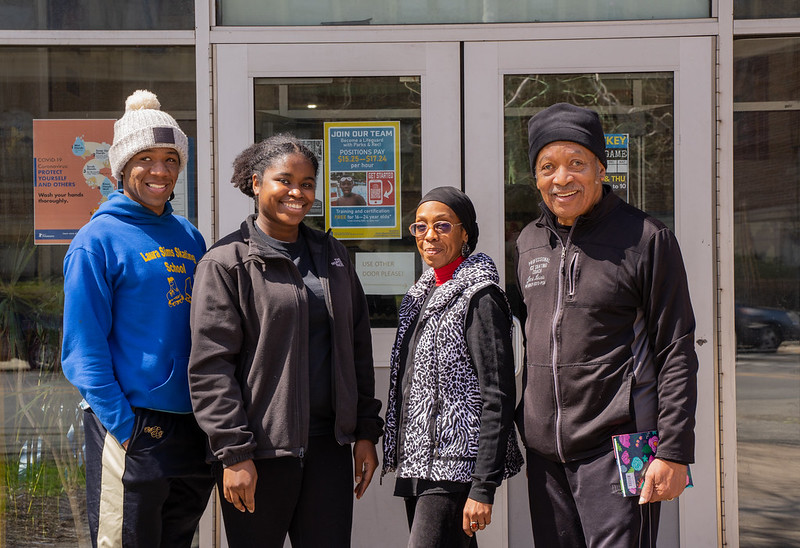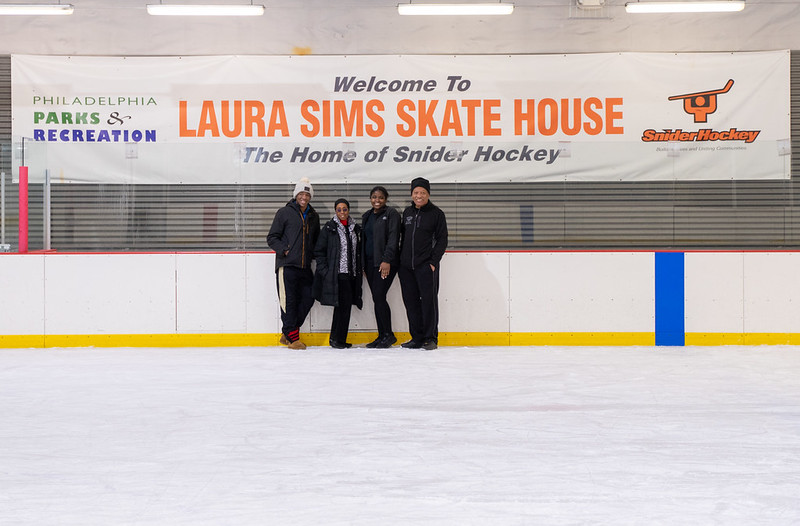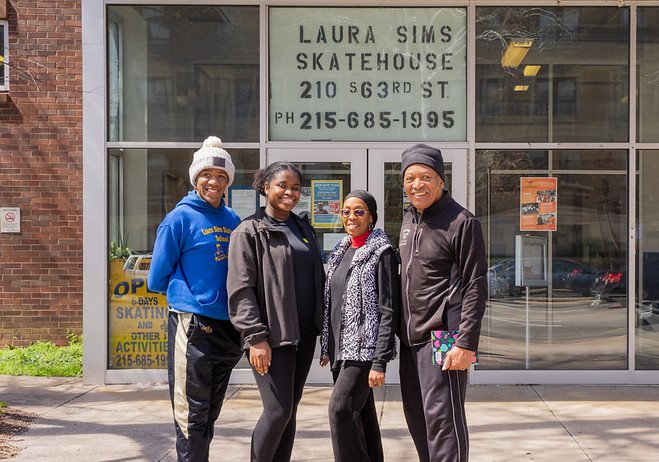Above: Johansson Jones, Jayda Jones, coach Sultana Muhammad and coach Jimi Lewis.
By Ed Rabinowitz
Thirty-seven years ago, Jimi Lewis posed for a photograph to help promote the opening of the Laura Sims Skating House in Philadelphia. He was, quite literally, the first person to step onto the ice at the new facility.
“The Daily News wanted a photo of someone standing on the ice, but all of the ice had not been laid yet,” Lewis recalls. “So they took a picture of me standing on a small section of ice, maybe 12 inches by 12 inches.”
Thirty-seven years later, the facility — the first ice skating rink built in a Black community, by and for the Black community — is still going strong. And so is Lewis.

The rink, which is located on West Philadelphia’s Cobbs Creek Parkway, opened in 1985. It was designed by Theodore Capers, the principal architect of Saxon & Capers, and fulfilled the dream of community resident and organizer Laura Sims that began in 1973.
Sims wanted to give the neighborhood children an opportunity to experience and develop a love for the sport that, historically, had only been experienced by children living in white and more affluent communities. She fought against the stereotype fostered by the City Council that a rink in Cobbs Creek was unnecessary because Black children didn’t skate.
So Sims demonstrated that seeing is believing.
“Laura would take a yellow school bus filled with kids from our community to a rink outside our area,” Lewis recalls. “She invited members of the City Council to her house for a breakfast meeting. And when they got there, the kids were getting on the bus to go to the skating rink.”
When council members asked what was happening, Sims explained that since the neighborhood did not have an ice skating rink, kids had to go elsewhere to learn to skate and have fun on the ice.
“I think that was the catalyst,” Lewis says.
Sultana Muhammad is the skating director at Laura Sims. A veteran skater who trained for two years under Mabel Fairbanks, the first Black skater inducted into the U.S. Figure Skating Hall of Fame, Muhammad is focused on promoting skating in general and the rink in particular throughout the community.
“There are still people who have been living in the community for 20 or 30 years, and they tell me they never knew there was ice skating,” Muhammad says. “How does that happen? So, I want to establish the rink as a Learn to Skate (USA) program, and introduce the sport to everyone.”
The rink offers classes to children as young as 3 years old, but also has a sizable adult class. Some of the adults have signed on for a chance to skate with their children; others never had the opportunity to learn as a child.
“The adults are always surprised they can skate,” says Lewis, who is acknowledged as the adult specialist.

Muhammad says Lewis “has a special way of communicating” with the adults. “And they love it. We do a big show at the end of the season, and everyone participates, from the little kids all the way up.”
The city-owned rink is highly accessible. Muhammad says the open skate sessions are free if people have their own skates; the cost to rent skates is $3. And six weeks of lessons cost $65.
“Nowhere in the city will you find a fee that low,” she says.
One of the reasons for the rink’s success over the years is the passion shared by the staff. Lewis has been an instructor at the rink since day one. He recently turned 79 and has no intention of slowing down.
“As long as my mind is good, if I can’t skate, put me in a chair, push me to the middle of the ice, and I’ll teach,” he says. “As long as I can think clearly, I can teach.”
And what the instructors teach goes beyond skating. For example, Muhammad tells students she wants them to be as good a skater as they want to be. But first and foremost, she wants them to learn how to be a good person.
“I’m more concerned with the skills they’ll learn and take with them outside the ice skating rink,” she explains. “That’s what we’re promoting here.”
Lewis echoes those thoughts. He says the discipline required to ice skate carries benefits beyond the rink.
“If you have the right teacher, and you connect with that teacher and learn to be disciplined, there wouldn’t be as much trouble, I feel, in kids’ lives today.”
Muhammad says the rink is community oriented. People from all backgrounds feel comfortable, feel welcomed when they’re there. And it’s the instructors’ love for skating that transcends the experience.
“I’ll teach on a Saturday from 9 a.m. until 11 a.m., but then I might be there the rest of the day,” Muhammad says. “People come in for open skate, and some don’t know what to do, so we take the time to help everyone. Jimi and I will sit around and tie people’s skates all day if you let us.”
But there’s one other element that drives Muhammad, that pulls her back to skating every time she has tried to walk away. And it dates back to the training she received from Fairbanks.
“I think of her,” she says. “I’m just trying to make Mabel proud, grow her legacy, and grow diversity in every aspect of the sport.”


